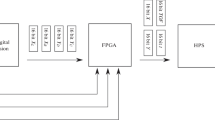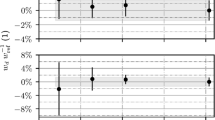Abstract
A software implementation of a loss-free counting multichannel analyzer, storing immediately into the multimegabyte memory of a low-cost 486 or Pentium type PC, enables the real-time control of a rabbit system as well as the collection of up to 1000 pairs of simultaneously recorded loss-corrected and non-corrected spectra of 16 k channels each, in a true sequence without time gaps in between, at throughput rates of up to 200 kc/s.1 Intended for activation analysis of short-lived isomeric transitions, the system renders possible peak to background optimizations and separations of lines with different half-lives without an a priori knowledge of sample composition by summing up appropriate numbers of spectra over appropriate intervals of time. By automatically adapting the noise filtering time to individual pulse intervals, the Preloaded Digital Filter (PLDF) combines low- to medium-rate resolutions comparable to those of high-quality Gaussian amplifiers with throughput rates of up to 100 kc/s, and high-rate resolutions superior to those of state-of-the-art gated integrator systems. In contrast to commercially available digital filters, the PLDF in its new implementation performs pulse shortening as well as pole zero cancellation in the analog domain. This not only results in a simpler digital core but also, for the first time, makes possible the use of a low-cost ADC in a spectrometric application.2 A simple but highly effective rabbit system is made from an aluminum incore part, inexpensive plastic tubing and an industrial pressurized air generator. Large sample containers have a volume of 25 cm3. Smaller containers of 5 cm3 are automatically separated from a transport capsule. A transport time of below 0.5 s enables activation analysis of short-lived isomeric transitions. The combination of rabbit system, PLDF and software based multichannel analyzer provides a low-cost but powerful solution for NAA at Triga reactors in developing countries, a forthcoming research project of the IAEA, Vienna.
Similar content being viewed by others
References
G. P. Westphal, H. Lemmel, F. Grass, R. Gwozdz, K. JÖstl, P. SchrÖder, E. Hausch, A Gamma Spectrometry System for Activation Analysis, lecture presented at the 5th Intern. Conf. on Methods Applications Radionanalytical Chemistry, Kona, HI, 2000, see: J. Radioanal. Nucl. Chem., 248 (2001) 53.
G. P. Westphal, K. JÖstl, P. SchrÖder, W. Winkelbauer, IEEE Trans. Nucl. Sci., 48 (2001) 461.
G. P. Westphal, H. Lemmel, Loss-Free Counting, lecture presented at the 3rd Intern. Symp. on Nuclear Analytical Chemistry, Halifax, Nova Scotia, 2001, see: J. Radioanal. Nucl. Chem., to be published.
Author information
Authors and Affiliations
Rights and permissions
About this article
Cite this article
Westphal, G.P., Grass, F., Lemmel, H. et al. Low-cost activation analysis at small research reactors. Journal of Radioanalytical and Nuclear Chemistry 257, 141–147 (2003). https://doi.org/10.1023/A:1024718031423
Issue Date:
DOI: https://doi.org/10.1023/A:1024718031423




